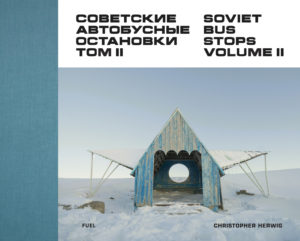“‘This is bullshit,’ I mumbled, through tears of exhaustion and frustration. The chances of the 4×4 climbing the snowy Goderdzi Pass were as slim as the likelihood that the bus stop at the summit was the prize I so desperately sought. Why was I still doing this after fifteen years, why couldn’t I stop?” (p. 198)
Christopher Herwig’s afterword to his second volume of Soviet Bus Stops poses the question that many readers would like to ask him, and he provides excellent answers. They’re irresistible, and not just to Herwig. “The attention [Soviet Bus Stops] receives around the world exceeds all my expectations.” (p. 198) He can’t quit them. “For the fifth time, I declare I’m finished with the project. Just days later, I find myself searching online for images of Russian bus stops.” (p. 198)
Writing about the first volume, I noted Russia’s conspicuous absence. Herwig explains, “I felt that a parallel existed between the bus stops as underdogs of architecture, and the former Soviet republics that were often overshadowed by Russia.” (p. 198) Russia calls to him, too. “However, as the book gained recognition, so Russian blogs and groups emerged celebrating their bus stops. These people had always appreciated them, but the book stimulated more open discussion.” (p. 198)
Herwig begins to plan a new volume and an odyssey. On a 30-day visa, he covers 15,000 kilometers, first in a loop near Moscow and then clear across Russia from Krasnodar to Vladivostok. Anyone else would have made a book of the journey — maybe Herwig will yet — but in Soviet Bus Stops, Volume II Herwig gives it three paragraphs. He is clearly a man of great focus. “As I approached Vladivostok, at the end of my journey, the bus stops became fewer and less impressive. Though happy in the knowledge that I’d exceeded my expectations, I couldn’t dispel the nagging feeling that I’d not yet reached my destination.” (p. 199) Maybe there is hope for a third volume.
The present volume has an introduction by Owen Hatherley, author of Landscapes of Communism. Whereas in the first volume Vera Kavalkova-Halvarsson, who grew up in a family of architects in Belarus, advanced the argument that the bus stops were an opening for individualism in a stultifying system, Hatherley, who is British, contends “we would be wrong to assume that the outpouring of creativity embodied in the bus stops was aimed against the system rather than its direct consequence.” (p. 8) It’s an interesting argument, but in the end seems stretched to me. Sure, the planners set up guidelines and in some cases that Hatherly documents did have firm ideas about how the overall landscape accompanying a road should appear — as a sort of Gesamtkunstwerk — but the madcap exuberance or just randomness that Herwig documents is at odds with the Soviet system. He gets closer to the mark near the end of his essay when he writes that a bus stop is “a product of the Soviet system, with its combination of command economics, public provision and a paradoxical bureaucratic chaos, where apparent conformity and regularity were bent and twisted at the edges.” (p. 13) And at more than just the edges.
Present politics makes its way into the volume, too. One of the stops from Yalta, on the Crimean peninsula, has been repainted in the Russian tricolor since that region was seized and annexed by Russia in 2014. Several of the stops in Ukraine are in that country’s gold and blue livery. History graces the pages: Herwig includes four photos from in and around Chernobyl.
The only stops from the book I have seen in person are some of the constructions in Georgia. However, that selection includes the one at the top of the Goderdzi Pass that Herwig struggled so hard to reach. I had the good sense to travel that route in summer. The Pass is the high point on 100 km or more of unpaved road along the way from Batumi on the Black Sea coast to Georgia’s ancient capital of Vardzia. It sounds like he approached the Pass from the east, and I can see why his vehicle protested. He made it, though, and took the shot that graces the book’s cover. “This wasn’t bullshit — it was brilliant.” (p. 190)




